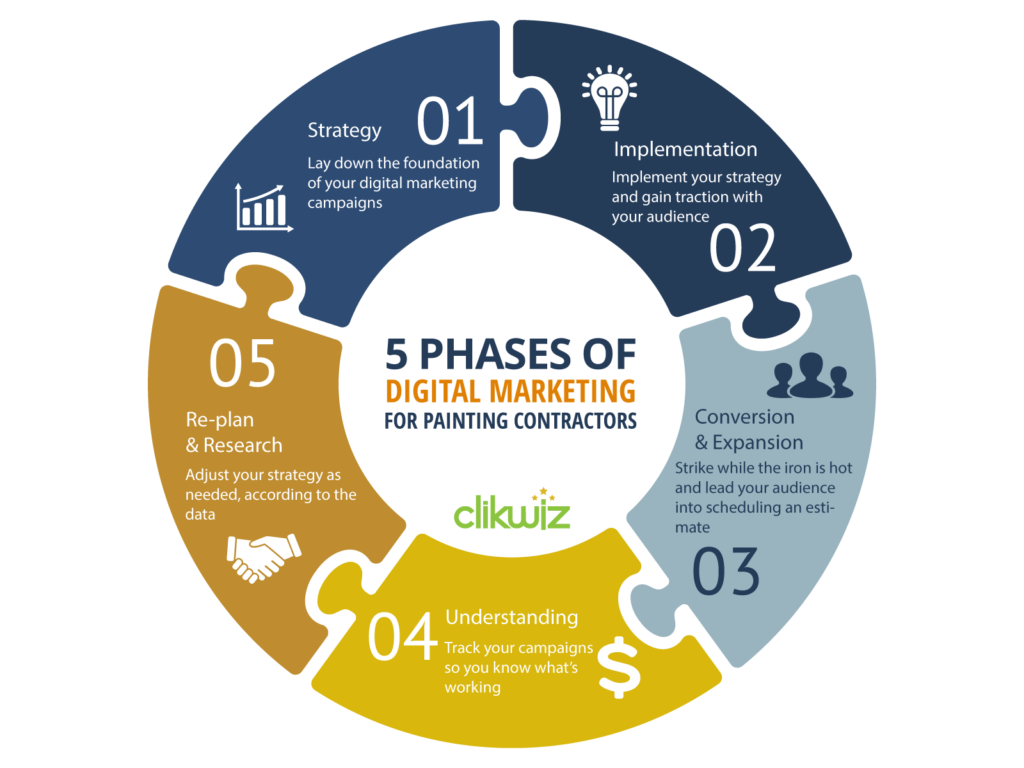Every industry has unique demands when it comes to digital marketing, and the world of painting contractors is no exception. By following a carefully laid out plan, you can maximize your online presence, drive business growth, and outshine your competitors. Today, we’ll dive into the five critical phases of digital marketing tailored explicitly for painting contractors:
Strategy
Implementation
Conversion & Expansion
Understanding
Re-plan & Research
Phase 1: Strategy – Lay down the foundation of your digital marketing campaigns.
The success of your digital marketing efforts depends largely on your initial strategy. This phase involves identifying your target audience, understanding their online behavior, setting clear marketing objectives, and establishing key performance indicators (KPIs).
Start by defining your ideal client. Are they homeowners, property managers, or real estate developers? What kind of painting services do they need? What are their digital habits? Answering these questions helps you tailor your content and advertising to attract the right audience.
Next, set your marketing objectives. These could be increasing website traffic, building brand awareness, generating leads, or boosting online bookings. Align these goals with your overall business objectives to ensure that your digital marketing supports your broader mission.
Lastly, establish your KPIs. These are measurable values that will help you determine if your campaign is successful. Some KPIs for painting contractors might include website visits, social media engagement, or leads generated from online sources.
Phase 2: Implementation – Implement your digital marketing strategy and gain traction with your audience.
Now that you have a strategy, it’s time to put it into action. This involves creating engaging content, optimizing your website for search engines (SEO), leveraging social media, and investing in paid advertising.
Create informative blog posts and video content that showcase your expertise and answer common questions about painting services. Optimize your website to rank higher in search engine results pages (SERPs), making it easier for potential clients to find you. Use social media to connect with your audience, showcasing your work and establishing your brand identity. Lastly, consider pay-per-click (PPC) advertising or social media ads to reach a broader audience quickly.
Phase 3: Conversion & Expansion – Strike while the iron is hot and lead your audience into scheduling an estimate.
At this stage, you’re looking to convert website visitors and social media followers into leads and, ultimately, customers. Use call-to-action (CTA) buttons, contact forms, and online booking tools to make it as easy as possible for potential clients to take the next step.
Consider offering online estimates, which can be a convenient option for potential clients and a powerful tool for your business. Follow up promptly on all leads and use email marketing to nurture potential customers who aren’t quite ready to book a service.
Phase 4: Understanding – Track your campaigns so you know what’s working.
Without tracking and analytics, it’s impossible to know what aspects of your digital marketing are working and what needs improvement. Use tools like Google Analytics and Facebook Insights to monitor website traffic, social media engagement, lead generation, and conversion rates.
Also, pay attention to metrics like bounce rate and session duration to understand how users are interacting with your website. High bounce rates or short session durations could indicate that users aren’t finding what they’re looking for, suggesting potential areas for improvement.
Data should drive your decision-making process. If your analytics show that a particular blog post is driving traffic, consider creating similar content. If your PPC ads aren’t generating enough leads, it may be time to adjust your ad copy or targeting.
Also, keep an eye on industry trends and evolving digital marketing best practices. Digital marketing is a dynamic field, and what worked yesterday may not work tomorrow. Always be ready to adjust your strategy as needed.
Remember, digital marketing is a marathon, not a sprint. It requires consistent effort, but by following these five phases, painting contractors can leverage the power of digital marketing to grow their businesses and gain a competitive edge in today’s digital-first world.

